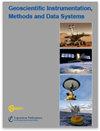风速对校正后的自动校准土壤蒸发室蒸发量的影响
IF 2.3
4区 地球科学
Q3 GEOSCIENCES, MULTIDISCIPLINARY
Geoscientific Instrumentation Methods and Data Systems
Pub Date : 2022-04-05
DOI:10.5194/gi-11-163-2022
引用次数: 3
摘要
摘要土壤蒸发关系到水和我们的生命支持来源,这对农业或气候变化预测科学很重要。一种简单的基于非稳态(NSS)技术的土壤蒸发测量仪器似乎是合适的。然而,由于NSS腔室技术具有高度侵入性,因此应特别注意纠正风速对蒸发过程的影响。土壤蒸发是一个复杂的过程,涉及土壤和空气的许多特性。测量室安装在土壤上及其头部的部署可能会干扰这些特性。因此,我们必须尽量减少差异或纠正测量结果。除了风速影响在腔室头内不可复制外,裸露土壤和带腔室头的土壤之间的大多数差异都可以最小化。同时,由于风的影响取决于许多无法实时监测的变量,因此开发了一种具有相应协议的自校准室,称为自动校准土壤蒸发呼吸室(ASERC),使测量在具有独特变量(风速,WS)的裸土上易于校正,而不考虑土壤成分,土壤质地和其他土壤或空气气象变量。该室遵循的一个简单的协议使我们能够确定土壤蒸发风速敏感性(Z)并校正测量结果,达到0.95作为决定系数。在实验室校准和“缓慢”传感器模拟中测量的沙质和粘性土壤蒸发的一些有趣发现也将在两个附录中报告。本文章由计算机程序翻译,如有差异,请以英文原文为准。
Wind speed influences corrected Autocalibrated Soil Evapo-respiration Chamber (ASERC) evaporation measures
Abstract. Soil evaporation concerns water and our life support sources, which are important for agriculture or for climate change prediction science.
A simple instrument based on the nonsteady-state (NSS) technique for soil
evaporation measurement appears suitable. However, because the NSS chamber
technique is highly invasive, special care should be provided to correct the
wind speed influence on the evaporation process. Soil evaporation is a
complex process that involves many soil and air characteristics. Measurement
chamber installation on the soil and its head deployment may perturb these
characteristics. We therefore had to minimize differences or to correct the
measurements. Most of the differences between bare soil and soil with a
deployed chamber head can be minimized, except for the wind speed influences
that are not reproducible inside a chamber head. Meanwhile, as the wind
influences depend on numerous variables that are not monitorable in real time, a self-calibrating chamber with a
corresponding protocol called the Autocalibrated Soil Evapo-respiration
Chamber (ASERC) was developed to
make the measurements easily corrigible on bare soil with a unique variable (wind speed, WS), regardless of the soil composition, soil texture, and other
soil or air meteorological variables. A simple protocol followed by this chamber
allows us to determine the soil evaporation wind speed susceptibility (Z)
and to correct the measurements achieving 0.95 as the coefficient of
determination. Some interesting findings on sandy and clayey soil
evaporation measured during laboratory calibration and “slow” sensor
simulation will also be reported in the two appendices.
求助全文
通过发布文献求助,成功后即可免费获取论文全文。
去求助
来源期刊

Geoscientific Instrumentation Methods and Data Systems
GEOSCIENCES, MULTIDISCIPLINARYMETEOROLOGY-METEOROLOGY & ATMOSPHERIC SCIENCES
CiteScore
3.70
自引率
0.00%
发文量
23
审稿时长
37 weeks
期刊介绍:
Geoscientific Instrumentation, Methods and Data Systems (GI) is an open-access interdisciplinary electronic journal for swift publication of original articles and short communications in the area of geoscientific instruments. It covers three main areas: (i) atmospheric and geospace sciences, (ii) earth science, and (iii) ocean science. A unique feature of the journal is the emphasis on synergy between science and technology that facilitates advances in GI. These advances include but are not limited to the following:
concepts, design, and description of instrumentation and data systems;
retrieval techniques of scientific products from measurements;
calibration and data quality assessment;
uncertainty in measurements;
newly developed and planned research platforms and community instrumentation capabilities;
major national and international field campaigns and observational research programs;
new observational strategies to address societal needs in areas such as monitoring climate change and preventing natural disasters;
networking of instruments for enhancing high temporal and spatial resolution of observations.
GI has an innovative two-stage publication process involving the scientific discussion forum Geoscientific Instrumentation, Methods and Data Systems Discussions (GID), which has been designed to do the following:
foster scientific discussion;
maximize the effectiveness and transparency of scientific quality assurance;
enable rapid publication;
make scientific publications freely accessible.
 求助内容:
求助内容: 应助结果提醒方式:
应助结果提醒方式:


